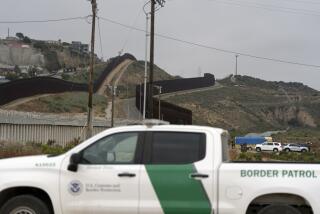Don’t fence them in
I stood on the cottonwood-lined banks of the San Pedro River in Arizona recently and watched it flow freely under a “water gap” fence -- two strands of barbed wire and two of wound cable. Those four strands, which mark the line between Mexico and the United States of America at the edge of the San Pedro Riparian National Conservation Area, are a modest boundary to be sure, as most of the border has been since 1848.
Soon, this border will get a much more powerful and disturbing representation. If the Department of Homeland Security and the Army Corps of Engineers have their way, a “vehicle barrier” made of railroad ties will cut across the river (although it will have to be removed each year before the monsoon floods, which would easily whisk it away). There are plans for permanent vehicle barriers just beyond the riverbed -- steel posts sunk into 3 feet of concrete. And for “pedestrian fencing” made of double rows of concrete-filled 14- to 17-foot-high bollards. And for the “Sandia”-style variant, which uses panels of tight steel mesh. There will be a new “all-weather” road, lighting and electronic surveillance towers.
And a price tag of $7 billion. For starters.
Faraway Washington has forgotten just how much cowboys can’t stand fences. And in this case, there are lots of cowboys: artists, students, activists, even politicians.
My guides of the San Pedro, for instance, were Greta Anderson, a Tucson-based environmental activist, and the accomplished painter Peter Young, a longtime Bisbee resident. The barbed wire is bad enough, said the artist, but this new fence would be “an atrocious scar upon the landscape.” The environmentalist spoke of jaguars and ocelots, of debris buildups and erosion and the possibility of the river itself “migrating.”
The San Pedro River, which runs atypically from south to north, will be virtually dammed as far as most people and many animals are concerned. Human migrants will be pushed from the river valley to torturous trails that cross the 9,000-foot-high peaks of the Huachuca Mountains; it is nearly certain the human death toll will begin to rise in the area.
This will happen because the Department of Homeland Security says so. The Secure Fence Act of 2006 mandates 700 miles of barriers, easily the most ambitious and controversial infrastructure project in border history. And although the department does indeed have the power to say so -- including the authority to waive National Environmental Policy Act rules in the name of national security -- resistance to the “wall” is proving to be a political obstruction Beltway politicos and Homeland Security functionaries hadn’t counted on.
It’s a new political convergence in the borderlands: environmentalists, social justice advocates and a cohort of new border activists who are apparently driven less by ideology than a simple Western love of open vistas -- and plain common sense.
This loose coalition bridges a long-standing political gap.
Historically, some who called themselves environmentalists were more likely to complain about litter on the migrant trail than migrant deaths, or say that population control was preferable to immigration reform. In the borderlands, the sheer dimensions of the human tragedy make such thinking morally reprehensible.
But the farther environmentalists get from the border, it seems, the less they understand how the “natural” and “human” realms intersect here. No mainstream national environmental organization, for example, lobbied in favor of immigration reform during last year’s debate. If they had, the outcome of the votes on both reform and the Secure Fence Act might have been different.
The bulldozers were already within sight of the San Pedro River last week when a federal judge stayed further construction in response to a joint appeal from Defenders of Wildlife and the Sierra Club, which argued that “immediate and irreparable harm” would come to the river and its ecosystem.
In Texas, meanwhile, several Lower Rio Grande communities also are threatening lawsuits against the Homeland Security Department. Brownsville Mayor Pat Ahumada said his city will “instruct DHS to stop the building of the wall.” Some local officials have stalled construction by blocking the department’s access to the border. (The federal government has a 60-foot right of way but must often cross private or local public property to get to it.)
At the University of Texas, Brownsville students marched against a proposed barrier that would literally cut off access to part of its campus.
On the Tohono O’odham Reservation in Arizona -- which overlays 74 miles of the border -- tribal Chairman Ned Norris Jr. declared that Homeland Security officials would build a wall through O’odham land only “over my dead body.” Traditional O’odham lands are bisected by the border, with about 1,400 tribal members living on the Mexican side; the construction of permanent vehicle barriers on the reservation already has begun to disrupt traditional cross-border pilgrimages.
In a few weeks, self-described “anarchists” will camp out on both sides of the line between Calexico, Calif., and Mexicali, Baja California. The group’s website tells of actions “against capitalism” and “for a world without borders.”
All of these join veterans of immigrants rights campaigns such as Tucson-based No More Deaths, which each summer focuses attention on the terrible toll of migrants who die of exposure in the deserts -- the most tangible result of the 1990s wall-building frenzy.
As for the political imagination that urges the fence into being, a kind of post-9/11 paranoid optimism is at work.
The Great Wall of America underscores a delusional faith in technology as the only solution to a problem that has nothing to do with technology. Ultimately, such Ozymandian monuments say more about the minds that conceived them than any “enemies” they actually contain. Think of the grandiose barriers of history -- the walls of Troy and China and Berlin; the wall that kept the Jews in the Warsaw Ghetto. Think of their fate, their ultimate symbolism. Each began with the idea that people -- and their ideas -- could be restrained by barriers, just like rivers can be dammed. A simple feat of engineering.
And yet we believe that our wall will be the exception.
Homeland Security Secretary Michael Chertoff has done his best to dress up the beast. During one news conference, he condescended to Texans fuming about their soon-to-be-erased view of the Rio Grande by assuring them the fence would be “aesthetically pleasing.” During another, he appropriated a thin slice of environmental rhetoric: The wall will be “good for the environment” because migrants would no longer leave a trail of litter.
The cowboys who can’t stand fences -- the environmentalists and artists, the anarchists and the migrants -- know that the wall will cause more death in the desert and leave a scar upon the land.
After visiting the San Pedro, I drove east along the border toward Naco, where the wall was then still going up. Front-end loaders ferried loads of steel. Cement trucks roared up and down the new all-weather road. Tall cranes lifted bollards, and workers gingerly guided them into a deep trench that stretched for miles into the iconic Western landscape of basin and range.
The fence was perfectly straight.
Nothing else was.
It will not work, because not even the greatest engineers can make a mad idea sane.
More to Read
Sign up for Essential California
The most important California stories and recommendations in your inbox every morning.
You may occasionally receive promotional content from the Los Angeles Times.










